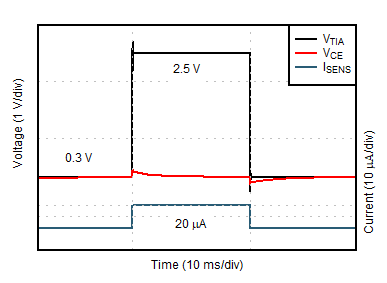SBOS925D December 2020 – April 2024 OPA2391 , OPA391
PRODMIX
- 1
- 1 Features
- 2 Applications
- 3 Description
- 4 Pin Configuration and Functions
-
5 Specifications
- 5.1 Absolute Maximum Ratings
- 5.2 ESD Ratings
- 5.3 Recommended Operating Conditions
- 5.4 Thermal Information: OPA391
- 5.5 Thermal Information: OPA2391
- 5.6 Thermal Information: OPA4391
- 5.7 Electrical Characteristics: OPA391DCK and OPA2391YBJ
- 5.8 Electrical Characteristics: OPA4391PW
- 5.9 Typical Characteristics
- 6 Detailed Description
- 7 Application and Implementation
- 8 Device and Documentation Support
- 9 Revision History
- 10Mechanical, Packaging, and Orderable Information
Package Options
Refer to the PDF data sheet for device specific package drawings
Mechanical Data (Package|Pins)
- DCK|5
Thermal pad, mechanical data (Package|Pins)
Orderable Information
7.2.1.3 Application Curve
 Figure 7-3 Sensor Transient Response to Simulated 300-ppm CO Exposure
Figure 7-3 Sensor Transient Response to Simulated 300-ppm CO Exposure